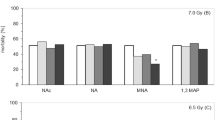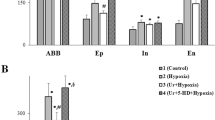Abstract
BOTH the oxidized disulphide, cystamine (—S—S—) and its corresponding sulphydryl amine, cysteamine (—SH) are excellent radioprotective agents in vivo 1. If rats, protected by the latter reduced substance, respire pure oxygen under pressure (4–5 atmospheres absolute) at the time of irradiation, the protective action is completely reversed2,3 and this result also applies to cysteine. Our own findings have shown that this reversal also applies to the pharmacologically active amines, histamine and adrenalin, and largely to 5-hydroxytryptamine (vide infra). The lessening of the radioprotective action of these reducing agents by an increased oxygen pressure in tissue fluids may be due to the inactivation of additional —SH and reducing groups supplied to the body, or due to an increase in physical solution and diffusion of oxygen so provided, in overcoming the anoxæmia caused by either decreased oxygen-carrying capacity of hæmoglobin (for example, with paraaminopropiophenone3), or by smooth muscle constriction in bronchioles or arterioles resulting from pharmacological action (for example, 5-hydroxytryptamine4). However, the protective disulphide, cystamine (—S—S—), is reduced to cysteamine (—SH), in vivo 5 and in vitro 6, and increased oxygen pressure in vivo may be expected to lessen its protective action, if the latter depends on the reduction of cystamine in tissues, to produce available —SH groups, or promote pharmacological activity, both of which tend to result in intracellular anoxia.
This is a preview of subscription content, access via your institution
Access options
Subscribe to this journal
Receive 51 print issues and online access
$199.00 per year
only $3.90 per issue
Buy this article
- Purchase on Springer Link
- Instant access to full article PDF
Prices may be subject to local taxes which are calculated during checkout
Similar content being viewed by others
References
Bacq, Z. M., and Alexander, P., “Fundamentals of Radiobiology” (Butterworths Sci. Pub., London, 1955).
Salerno, P. R., and Friedell, H. L., A.E.M.R. Project W31-109-eng-78, No. 4920 (1955).
Salerno, P. R., Uyeki, E., and Friedell, H. L., A.E.M.R. Project W31-109-eng-78, No. 4924 (1955).
Van den Brenk, H. A. S., and Elliott, K., Nature, 182, 1506 (1958).
Fischer, P., and Goutier-Pirotte, M., Arch. Int. Physiol., 62, 76 (1954).
Bacq, Z. M., Fischer, P., and Pirotte, M., Arch. Int. Physiol., 60, 559 (1952).
Smith, D. E., Patt, H. M., and Tyree, E. B., Argonne Nat. Lab. Rep., No. 4401, 72 (1950).
Van den Brenk, H. A. S., and Moore, R., Proc. Sec. Aust. Congr. Radiobiol. Rep. (in the press).
Pihl, A., and Eldjarn, L., “Progress in Radiobiology”, 147 (Oliver and Boyd, Edinburgh, 1957).
Patt, H. M., Physiol. Rev., 33, 35 (1953).
Author information
Authors and Affiliations
Rights and permissions
About this article
Cite this article
VAN DEN BRENK, H., MOORE, R. Effect of High Oxygen Pressure on the Protective Action of Cystamine and 5-Hydroxytryptamine in Irradiated Rats. Nature 183, 1530–1531 (1959). https://doi.org/10.1038/1831530a0
Issue Date:
DOI: https://doi.org/10.1038/1831530a0
This article is cited by
-
Comments on the mechanisms of action of radiation protective agents: basis components and their polyvalence
SpringerPlus (2014)
-
Serotonin preparations
Pharmaceutical Chemistry Journal (1971)
-
Pharmacological investigation of the mechanism of the radioprotective effect of catecholamines
Bulletin of Experimental Biology and Medicine (1969)
-
Nervous component in the mechanism of action of radioprotective substances
Bulletin of Experimental Biology and Medicine (1967)
-
Chemical Protection against Alpha-Particle Irradiation
Nature (1962)
Comments
By submitting a comment you agree to abide by our Terms and Community Guidelines. If you find something abusive or that does not comply with our terms or guidelines please flag it as inappropriate.



